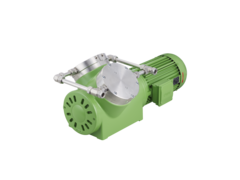KNF diaphragm gas pumps transfer or compress gases and vapors and generate a vacuum without contaminating...
Diaphragm Pumps Safeguard Insulating Gas of Electrical Systems
For the safe handling of electrical currents in medium to high voltage applications, insulating gases such as SF6 are essential for the protection of electrical systems. Having a significant impact on the environment, they require strictly closed systems.

Insulating gases, such as sulfur hexafluoride, play a critical role in protecting electrical systems. They are widely used in high-voltage power systems, switchgears and transformers to ensure operational safety, reduce the risk of electrical failures and short circuits. Their unique properties also allow smaller clearances between electrical components. However, the particularly high global warming potential of sulfur hexafluoride requires the strict safety of closed systems to prevent the gas from escaping into the environment.
SF6 Gas for Circuit Breaker and Switchgear Safety
Sulfur hexafluoride (SF6) is one of the most widely used insulating gases. Its excellent electrical and thermal properties make it an ideal choice for use in gas-insulated switchgears, breakers, and gas-insulated lines found in the transmission and distribution (T&D) industry. In the event of an arc, the six fluorine molecules of SF6 can separate from the sulfur and capture electrons, effectively extinguishing the arc. The gas then self-heals by returning its molecules to their original configuration.
While sulfur hexafluoride is non-toxic, colorless, odorless, non-flammable and chemically inert, and is widely used as a robust insulator and the aforementioned arc extinguisher in medium- and high-voltage power transmission and distribution applications, it is not without environmental impact. SF6 is nearly 25,200 times more effective at trapping heat than carbon dioxide (CO2). This makes SF6 one of the most potent greenhouse gases with an extremely high global warming potential (GWP). It is therefore important to constantly monitor electrical systems for SF6 leaks.
Diaphragm Pumps Maintain the Integrity of High-Voltage Systems
To ensure gas tightness and prevent SF6 leakage, diaphragm pumps play a key role in protecting the integrity of high-voltage systems and contributing to environmental responsibility. Diaphragm pumps can perform three important functions to maintain a closed system and safely handle the insulating gas.
- Extract SF6: Diaphragm pumps are used to efficiently and safely extract SF6 gas from the system during maintenance or repair operations. These pumps ensure that the gas is removed without leakage or emissions, maintaining the integrity of the system.
- Evacuate Air or Nitrogen: Diaphragm pumps play a critical role in creating a clean and controlled environment within the system by effectively evacuating air or nitrogen. By removing unwanted gases, the pumps help maintain the purity of the SF6 gas and prevent contamination, ensuring optimal performance.
- Refill SF6: After evacuation and cleaning, diaphragm pumps are responsible for refilling the system with SF6 gas. Their precise control of pressure and flow enables accurate and efficient replenishment, ensuring that the system remains properly insulated and operates safely and reliably.
Efficiency Through Customization
Pure sulfur hexafluoride as an inert gas is not harmful to metals. However, when contaminated with water, certain corrosive by-products can be formed during arc extinguishing processes. Customization allows diaphragm pumps to be tailored to meet these specific needs, ensuring optimal performance and efficiency. Features such as material selection, sealing mechanisms and control systems can be customized to optimize the pump's compatibility with SF6 gas and minimize the risk of leakage.
With adaptations such as stainless steel piping and increased tightness of ≤ 1x10-4 mbar x l/s, diaphragm pumps, such as the KNF N 1400, also allow precise control of pressure and flow rate to ensure optimum delivery of sulfur hexafluoride to the insulation system. This not only ensures reliable insulation, but also minimizes the risk of leakage and environmental impact.

